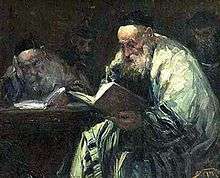Chronicle of Moses
The Chronicle of Moses (Hebrew: דברי הימים של משה) is one of the smaller midrashim. In this midrash, which is written in pure (pseudo-biblical) Hebrew, and which is in many portions only provides a mere hint of verses from the Bible in a close imitation of Biblical style, is presented a history of the life of Moses embellished with many legends.
These legends must be very old, since the same or similar stories are found as early as Josephus (Ant. ii. 9, §§ 2 et seq.).; viz., the stories of the wise men's prophecy to the king of a birth of a child who some day will destroy the power of the Egyptians (in the midrash the interpretation of a dream replaces the prophecy; comp. also Targ. Yer. 1 to Ex. i. 15), upon which prophecy followed the command of the king to cast the male children of the Israelites into the river; the crown which the king places upon Moses' head, and which the latter casts to the earth (in the midrash Moses is described as taking the crown from the king's head); Moses as leader of the Israelites in a war against the Ethiopians, his use of the ibis in combating the snakes that have made his way dangerous, and the love of the king's daughter for him (according to the midrash Moses enters the camp of the Ethiopian king קיקנוס, upon whose death he marries the latter's widow, and, overcoming the dangers due to the snakes, captures the long-besieged city).
According to A. Jellinek (B. H. ii., p. viii.), the life of Moses was originally treated in detail in a chronicle which employed sources still older. This work was incorporated in the well-known collection of legends entitled Sefer ha-Yashar; and from this the Yalḳuṭ took extracts which agree with the Sefer ha-Yashar and not with the present Chronicle of Moses. At a later time, however, a shorter recension of the older chronicle was made, which is the one now existing. According to Strack & Stemberger (1991), the work probably dates to the 10th or 11th century. It was published at Constantinople in 1516, at Venice in 1564, and elsewhere, and was reprinted by Jellinek (l.c. ii. 1-13). Extracts were made from the chronicle by the author of the Midrash Wayosha; and it was one of the sources of the Shemot Rabbah; it was likewise cited in the Aruk, by Ibn Ezra (who rejects it as apocryphal) on Ex. ii. 22, and by Samuel ben Meïr on Book of Numbers.
Bibliography
 This article incorporates text from a publication now in the public domain: Jewish Encyclopedia. 1901–1906.
. The JE cites the following works.
This article incorporates text from a publication now in the public domain: Jewish Encyclopedia. 1901–1906.
. The JE cites the following works.
- Zunz, G. V. p. 145;
- Rab Pe'alim, p. 45;
- A. Jellinek, B. H. ii., pp. vii. et seq.
- Strack, H.L.; Stemberger, G. (1991), Introduction to the Talmud and Midrash, Edinburgh: T&T Clark, ISBN 978-0-8006-2524-5.
